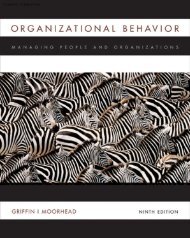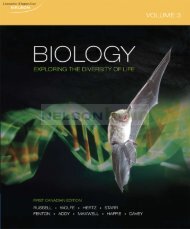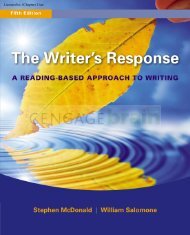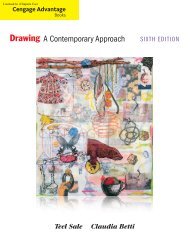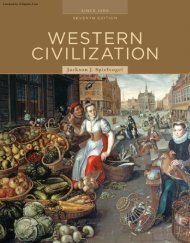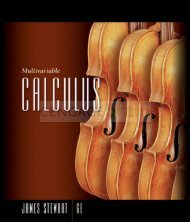Understanding Statistics in the Behavioral Sciences ... - NelsonBrain
Understanding Statistics in the Behavioral Sciences ... - NelsonBrain
Understanding Statistics in the Behavioral Sciences ... - NelsonBrain
Create successful ePaper yourself
Turn your PDF publications into a flip-book with our unique Google optimized e-Paper software.
Licensed to:<br />
10 C H A P T E R 1 <strong>Statistics</strong> and Scientifi c Method<br />
but usually it is far too costly, so a sample is taken. Note that not just any sample<br />
will do. The sample should be a random sample. Random sampl<strong>in</strong>g is discussed <strong>in</strong><br />
Chapter 8. For now, it is suffi cient to know that random sampl<strong>in</strong>g allows <strong>the</strong> laws of<br />
probability, also discussed <strong>in</strong> Chapter 8, to apply to <strong>the</strong> data and at <strong>the</strong> same time<br />
helps achieve a sample that is representative of <strong>the</strong> population. Thus, <strong>the</strong> results<br />
obta<strong>in</strong>ed from <strong>the</strong> sample should also apply to <strong>the</strong> population. Once <strong>the</strong> data are<br />
collected, <strong>the</strong>y are statistically analyzed and <strong>the</strong> appropriate conclusions about <strong>the</strong><br />
population are drawn.<br />
DESCRIPTIVE AND INFERENTIAL STATISTICS<br />
def<strong>in</strong>itions<br />
Statistical analysis, of course, is <strong>the</strong> ma<strong>in</strong> <strong>the</strong>me of this textbook. It has been divided<br />
<strong>in</strong>to two areas: (1) descriptive statistics and (2) <strong>in</strong>ferential statistics. Both <strong>in</strong>volve analyz<strong>in</strong>g<br />
data. If an analysis is done for <strong>the</strong> purpose of describ<strong>in</strong>g or characteriz<strong>in</strong>g <strong>the</strong><br />
data, <strong>the</strong>n we are <strong>in</strong> <strong>the</strong> area of descriptive statistics. To illustrate, suppose your biology<br />
professor has just recorded <strong>the</strong> scores from an exam he has recently given you. He hands<br />
back <strong>the</strong> tests and now wants to describe <strong>the</strong> scores. He might decide to calculate <strong>the</strong><br />
average of <strong>the</strong> distribution to describe its central tendency. Perhaps he will also determ<strong>in</strong>e<br />
its range to characterize its variability. He might also plot <strong>the</strong> scores on a graph<br />
to show <strong>the</strong> shape of <strong>the</strong> distribution. S<strong>in</strong>ce all of <strong>the</strong>se procedures are for <strong>the</strong> purpose<br />
of describ<strong>in</strong>g or characteriz<strong>in</strong>g <strong>the</strong> data already collected, <strong>the</strong>y fall with<strong>in</strong> <strong>the</strong> realm of<br />
descriptive statistics.<br />
Inferential statistics, on <strong>the</strong> o<strong>the</strong>r hand, is not concerned with just describ<strong>in</strong>g <strong>the</strong><br />
obta<strong>in</strong>ed data. Ra<strong>the</strong>r, it embraces techniques that allow one to use obta<strong>in</strong>ed sample<br />
data to make <strong>in</strong>ferences or draw conclusions about populations. This is <strong>the</strong> more complicated<br />
part of statistical analysis. It <strong>in</strong>volves probability and various <strong>in</strong>ference tests,<br />
such as Student’s t test and <strong>the</strong> analysis of variance.<br />
To illustrate <strong>the</strong> difference between descriptive and <strong>in</strong>ferential statistics, suppose<br />
we were <strong>in</strong>terested <strong>in</strong> determ<strong>in</strong><strong>in</strong>g <strong>the</strong> average IQ of <strong>the</strong> entire freshman class at your<br />
university. It would be too costly and time-consum<strong>in</strong>g to measure <strong>the</strong> IQ of every<br />
student <strong>in</strong> <strong>the</strong> population, so we would take a random sample of, say, 200 students and<br />
give each an IQ test. We would <strong>the</strong>n have 200 sample IQ scores, which we want to use<br />
to determ<strong>in</strong>e <strong>the</strong> average IQ <strong>in</strong> <strong>the</strong> population. Although we can’t determ<strong>in</strong>e <strong>the</strong> exact<br />
value of <strong>the</strong> population average, we can estimate it us<strong>in</strong>g <strong>the</strong> sample data <strong>in</strong> conjunction<br />
with an <strong>in</strong>ference test called Student’s t test. The results would allow us to make a statement<br />
such as, “We are 95% confi dent that <strong>the</strong> <strong>in</strong>terval of 115–120 conta<strong>in</strong>s <strong>the</strong> mean IQ<br />
of <strong>the</strong> population.” Here, we are not just describ<strong>in</strong>g <strong>the</strong> obta<strong>in</strong>ed scores, as was <strong>the</strong> case<br />
with <strong>the</strong> biology exam. Ra<strong>the</strong>r, we are us<strong>in</strong>g <strong>the</strong> sample scores to <strong>in</strong>fer to a population<br />
value. We are <strong>the</strong>refore <strong>in</strong> <strong>the</strong> doma<strong>in</strong> of <strong>in</strong>ferential statistics. Descriptive and <strong>in</strong>ferential<br />
statistics can be defi ned as follows:<br />
■ Descriptive statistics is concerned with techniques that are used to describe or<br />
characterize <strong>the</strong> obta<strong>in</strong>ed data.<br />
■ Inferential statistics <strong>in</strong>volves techniques that use <strong>the</strong> obta<strong>in</strong>ed sample data to<br />
<strong>in</strong>fer to populations.<br />
Copyright 2011 Cengage Learn<strong>in</strong>g. All Rights Reserved. May not be copied, scanned, or duplicated, <strong>in</strong> whole or <strong>in</strong> part. Due to electronic rights, some third party content may be suppressed from <strong>the</strong> eBook and/or eChapter(s).<br />
Editorial review has deemed that any suppressed content does not materially affect <strong>the</strong> overall learn<strong>in</strong>g experience. Cengage Learn<strong>in</strong>g reserves <strong>the</strong> right to remove additional content at any time if subsequent rights restrictions require it.





